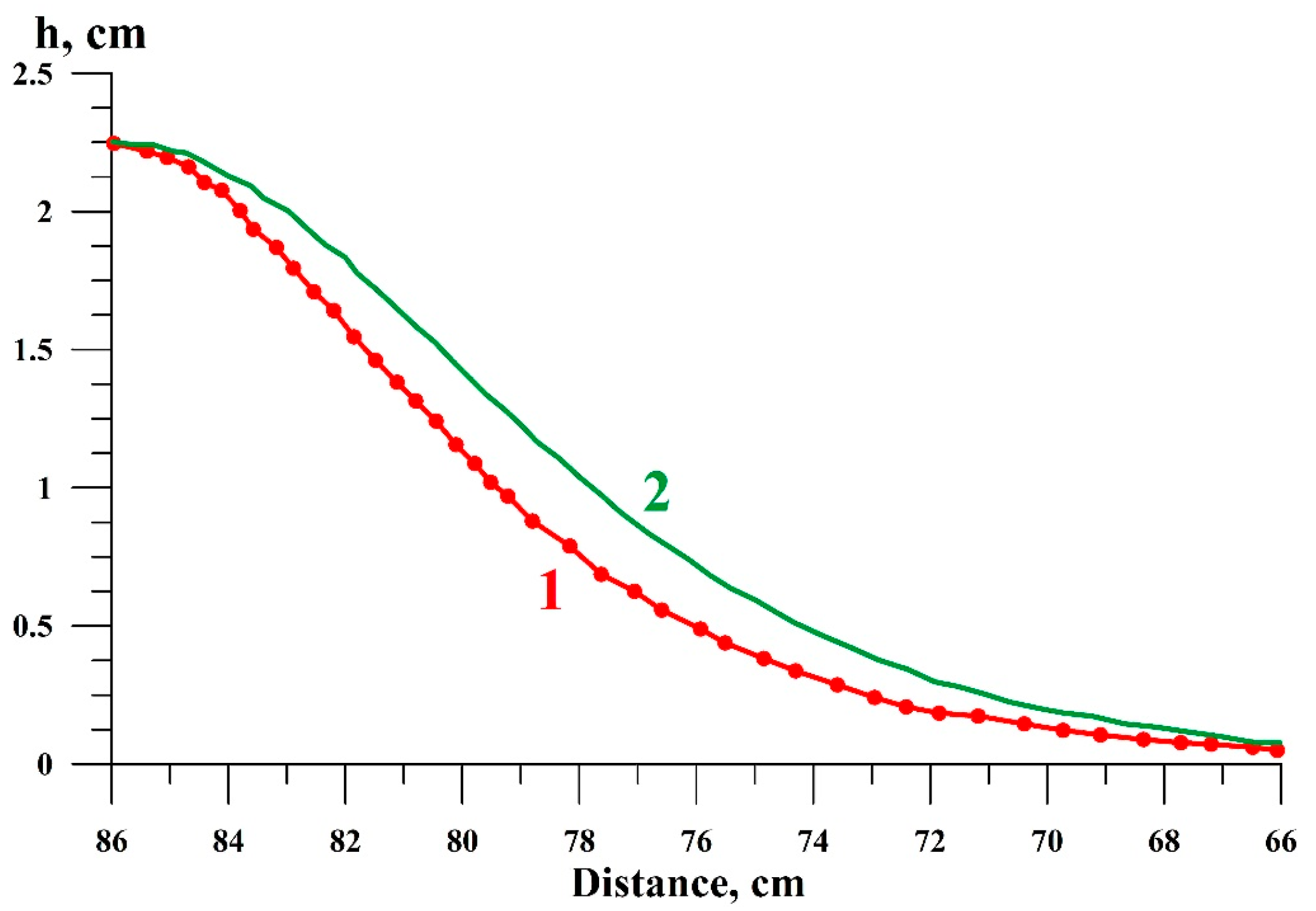Estimating Secondary Earthquake Aftershocks from Tsunamis
Abstract
:1. Introduction
2. The Ocean’s Impact: A Brief Description
3. Analysis of Nonlinear Boundary Conditions
4. Discussion and Conclusions
Author Contributions
Funding
Data Availability Statement
Acknowledgments
Conflicts of Interest
References
- Turcotte, D.; Schubert, G. Geodynamics, 3rd ed.; Cambridge University Press: Cambridge, UK, 2014; p. 636. [Google Scholar] [CrossRef]
- Khain, V.E.; Lomize, M.G. Geotectonics with Basics of Geodynamics; Moscow State University: Moscow, Russia, 1995; p. 480. (In Russian) [Google Scholar]
- Aleinikov, A.L.; Belikov, V.T.; Eppelbaum, L.V. Some Physical Foundations of Geodynamics; Kedem Printing-House: Tel Aviv, Israel, 2001; p. 172. [Google Scholar]
- Stüwe, K. Geodynamics of the Lithosphere; Springer: Berlin/Heidelberg, Germany, 2007; p. 493. [Google Scholar]
- Riguzzi, F.; Panza, G.; Varga, P.; Doglioni, K. Can Earth’s rotation and tidal despinning drive plate tectonics? Tectonophysics 2010, 484, 60–73. [Google Scholar] [CrossRef]
- Zaccagnino, D.; Vespe, F.; Doglioni, C. Tidal modulation of plate motions. Earth Sci. Rev. 2020, 205, 103179. [Google Scholar] [CrossRef]
- Popov, V.L. Mechanics of Contact Interaction and Physics of Friction. From Nanotribology to Earthquake Dynamics; Fizmatlit: Moscow, Russia, 2013; p. 352. (In Russian) [Google Scholar]
- Cox, C.J.; Cooker, M.J. The motion of a rigid body impelled by sea-wave impact. Appl. Ocean Res. 1999, 21, 113–125. [Google Scholar] [CrossRef]
- Saito, S. Tsunami Generation and Propagation; Springer: Tokyo, Japan, 2019; p. 265. [Google Scholar] [CrossRef]
- Tilling, R.I. (Ed.) Complexity in Tsunamis, Volcanoes, and Their Hazards; Springer: New York, NY, USA, 2022; p. 752. [Google Scholar] [CrossRef]
- Dodd, R.K.; Eilbeck, J.C.; Gibbon, J.D.; Morris, H.C. Solitons and Nonlinear Wave Equations; Academic Press: New York, NY, USA, 1982; p. 630. [Google Scholar]
- Newell, A.C. Solitons in Mathematics and Physics; CBMS-NSF Regional Conference Series in Applied Mathematics, Ser. No. 48; Society for Industrial and Applied Mathematics: Philadelphia, PA, USA, 1987; p. 240. [Google Scholar]
- Whitham, G.B. Linear and Nonlinear Waves; John Wiley & Sons: New York, NY, USA, 2011; p. 660. [Google Scholar] [CrossRef]
- de Jager, E.M. On the Origin of the Korteweg-de Vries Equation. arXiv 2011, arXiv:math/0602661. [Google Scholar] [CrossRef]
- Guo, B.; Pang, X.-F.; Wang, Y.F.; Liu, N. Solitons; Walter de Gruyter: Berlin, Germany; Boston, MA, USA, 2018; p. 367. [Google Scholar]
- Arsen’yev, S.A.; Eppelbaum, L.V. Nonlinear model of coastal flooding by a highly turbulent tsunami. J. Nonlinear Math. Phys. 2021, 28, 436–451. [Google Scholar] [CrossRef]
- Arsen’yev, S.A.; Eppelbaum, L.V. The Behavior of Nonlinear Tsunami Waves Running on the Shelf. New Challenges in Seismic Hazard Assessment. Appl. Sci. 2023, 13, 8112. [Google Scholar] [CrossRef]
- Arcas, D.; Segur, H. Seismically generated tsunamis. Phil. Trans. R. Soc. A. 2012, 370, 1505–1542. [Google Scholar] [CrossRef] [PubMed]
- Assier-Rzadkiewicz, S.; Heinrich, P.; Sabatier, P.C.; Savoye, B.; Bourillet, J.F. Numerical modelling of a landslide-generated tsunami: The 1979 nice event. Pure Appl. Geophys. 2000, 157, 1707–1727. [Google Scholar] [CrossRef]
- Suppasri, A.; Maly, E.; Kitamura, M.; Syamsidik; Pescaroli, G.; Alexander, D.; Imamura, F. Cascading disasters triggered by tsunami hazards: A perspective for critical infrastructure resilience and disaster risk reduction. Int. J. Disaster Risk Reduct. 2021, 66, 102597. [Google Scholar] [CrossRef]
- Zengaffinen-Morris, T.; Urgeles, R.; Løvholt, F. On the inference of tsunami uncertainties from landslide run-out observations. J. Geophys. Res. Ocean. 2022, 127, e2021JC018033. [Google Scholar] [CrossRef]
- Lo, P.H.-Y. Analytical and numerical investigation on the energy of free and locked tsunami waves generated by a submarine landslide. Phys. Fluids 2023, 35, 046601. [Google Scholar] [CrossRef]
- Korsgaard, N.J.; Svennevig, K.; Søndergaard, A.S.; Luetzenburg, G.; Oksman, M.; Larsen, N.K. Giant mid-Holocene landslide-generated tsunamis recorded in lake sediments from Saqqaq, West Greenland. Nat. Hazards Earth Syst. Sci. 2024, 24, 757–772. [Google Scholar] [CrossRef]
- Smith, E.H. (Ed.) Mechanical Engineer’s Reference Book, 12th ed.; Buttenvorth-Heinemann: Oxford, UK, 2000; p. 1194. [Google Scholar]
- Tkhonov, A.N.; Samarsky, A.A. Equations of Mathematical Physics; Dover Publications: New York, NY, USA, 2013; p. 800. [Google Scholar]
- Arsen’yev, S.A. Towards the theory of long waves on water. Doklady Russ. Acad. Sci. 1994, 334, 635–638. [Google Scholar]
- Renouard, D.P.; Seabra Santos, F.L.; Temperville, A.M. Experimental study of the generation, damping, and reflation of a solitary wave. Dyn. Atmos. Ocean. 1985, 9, 341–358. [Google Scholar] [CrossRef]
- Fritz, H.M.; Mohammed, F.; Yoo, G. Lituya Bay Landslide Impact Generated Mega-Tsunami 50th Anniversary. Pure Appl. Geophys. 2009, 166, 153–175. [Google Scholar] [CrossRef]
- International SWOT Satellite Spots Planet-Rumbling Greenland Tsunami. 30 October 2024. Available online: https://www.nasa.gov/missions/swot/international-swot-satellite-spots-planet-rumbling-greenland-tsunami/ (accessed on 8 November 2024).
- Dimova, L.; Raykova, R. Tsunami Radiation Pattern in the Eastern Mediterranean. J. Phys. Technol. 2017, 1, 22–27. [Google Scholar]
- Diniz, P.S.R.; Suykens, J.A.K.; Theodoridis, S.R. (Eds.) Signal Processing Theory and Machine Learning; Academic Press: Cambridge, MA, USA, 2023; p. 1234. [Google Scholar]


Disclaimer/Publisher’s Note: The statements, opinions and data contained in all publications are solely those of the individual author(s) and contributor(s) and not of MDPI and/or the editor(s). MDPI and/or the editor(s) disclaim responsibility for any injury to people or property resulting from any ideas, methods, instructions or products referred to in the content. |
© 2024 by the authors. Licensee MDPI, Basel, Switzerland. This article is an open access article distributed under the terms and conditions of the Creative Commons Attribution (CC BY) license (https://creativecommons.org/licenses/by/4.0/).
Share and Cite
Arsen’yev, S.A.; Eppelbaum, L.V. Estimating Secondary Earthquake Aftershocks from Tsunamis. Geosciences 2024, 14, 344. https://doi.org/10.3390/geosciences14120344
Arsen’yev SA, Eppelbaum LV. Estimating Secondary Earthquake Aftershocks from Tsunamis. Geosciences. 2024; 14(12):344. https://doi.org/10.3390/geosciences14120344
Chicago/Turabian StyleArsen’yev, Sergey A., and Lev V. Eppelbaum. 2024. "Estimating Secondary Earthquake Aftershocks from Tsunamis" Geosciences 14, no. 12: 344. https://doi.org/10.3390/geosciences14120344
APA StyleArsen’yev, S. A., & Eppelbaum, L. V. (2024). Estimating Secondary Earthquake Aftershocks from Tsunamis. Geosciences, 14(12), 344. https://doi.org/10.3390/geosciences14120344






